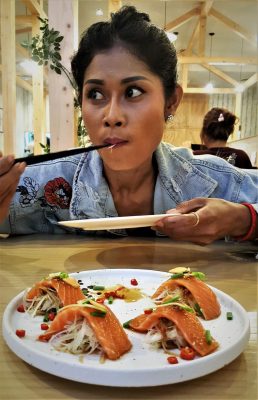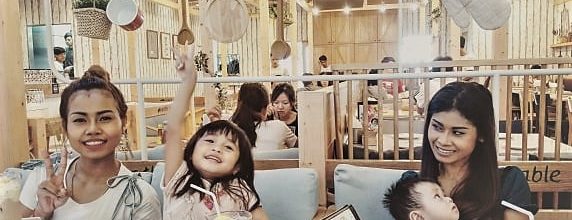
On The Table – Tokyo Café
AEON Mall II – Sen Sok City, Phnom Penh
I’ve never been big on Mall restaurants, eateries or bars, the whole concept just seems like it’s all faux atmosphere, cooking by numbers and service with a feeding-the-masses kind of vacant smile.
It’s not a destination where I go to enjoy the quality of the food, or for the dining experience itself and is -most often- somewhere that I just grab a feed before catching a movie with my wife or, after playtime at the fun-zone with our 8-year-old little sister, 3-year-old niece and 6-month-old nephew, (who all live with us).
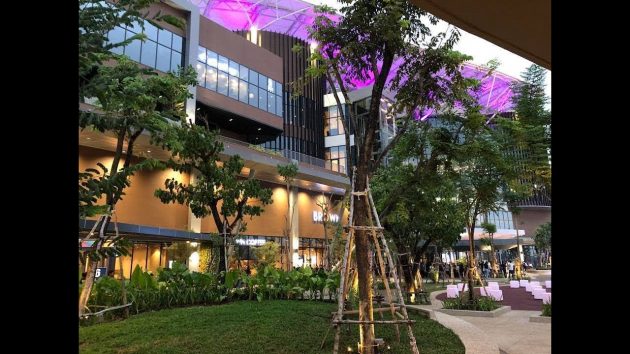
So, it was with some serious reservations that I made the long journey across town and out over to Sen Sok with the kids, but off we went, because I knew they were bored and I was advised to check it out. The trip out was certainly a bit of a journey; I remember well -even before the traffic jams came to Phnom Penh- when friends would complain that heading to Toul Kouk was ‘too far out of town’, when it used to take all of about 20 minutes to get out there. Sen Sok is some way out past Toul Kouk, northwest of the city. Sadly, I now feel that any trip on the roads of Phnom Penh comes with a significant risk of accident, injury or much, much worse.
Sen Sok only became an official administrative center in 2009, before then it was just another patch of Kandal province, which surrounds Phnom Penh like circled wagons. Go back a decade or two and there really was no suburban sprawl in the capital of Cambodia, crossing the border between Phnom Penh City and Kandal Province was to step immediately out of urban decay and into rural agriculture and village life: it really was such a contrast that a journey of a mere 15 or 20 kilometers could feel like you had traveled back in time.
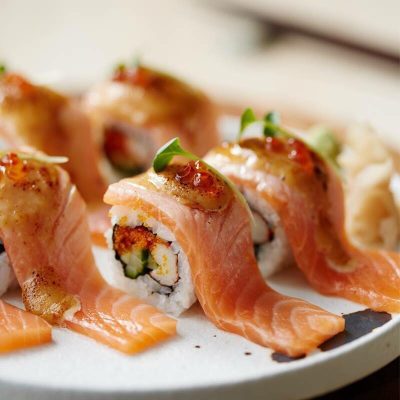
Cities drag in populations like casinos drag in punters, the promise of at least a chance at a better life seems irresistible. Such has been the growth in Phnom Penh, that the vacant fields around its outskirts, places like Sen Sok are exploding with gated estates, apartment towers, wedding venues that themselves look like giant wedding cakes, rows and rows of shop houses, International schools and modern shopping malls. The same scene is playing out in every direction out of the capital, at various stages of development. All of a sudden, the capital has a sprawling suburbia, satellite cities and outlying communities; one can only hope that the necessary infrastructure eventually catches up.
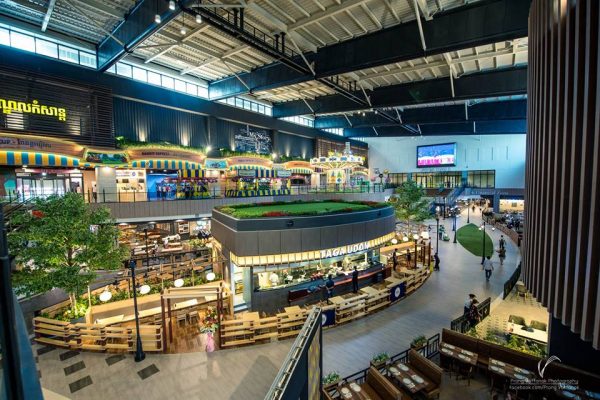
Sen Sok is indeed impressive and AEON Mall II sets the benchmark for shopping meccas in the capital, more an oasis away from the concrete jungle and wheezing, snarling traffic, a place to chill and hang out with the family. Not the boring necessary destination to perform the chore of shopping. There are nice gardens, open spaces and plenty of activity-based outlets for kids. There is also, (to this reviewer) a staggering amount of food outlets, from western fast-food chains to Asian style hot-pots, BBQ’s, noodle bars, hawker-stalls and buffets, through to the slightly more upmarket family styled Chinese, Japanese and Thai restaurants.
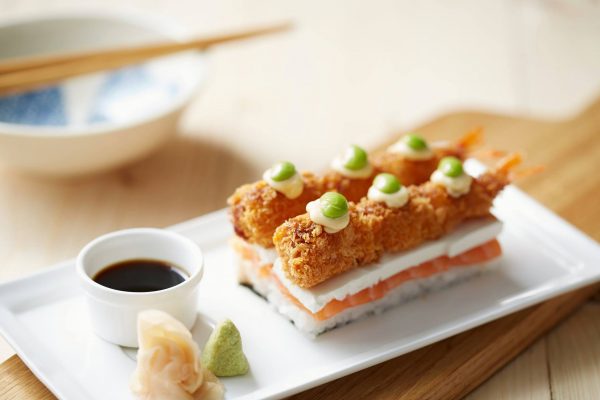
I have now been out there three times in the last two weeks! First, I took the kids out there, they loved it, wife saw the pics and wanted to go so, we went and saw Aquaman there at Cambodia’s only IMAX theatre. Shopping, dinner and movie, she loved all of it! Then sister wanted to see it too (and kids wanted to go back) so, we went again, this past weekend and again, everyone had a ball!
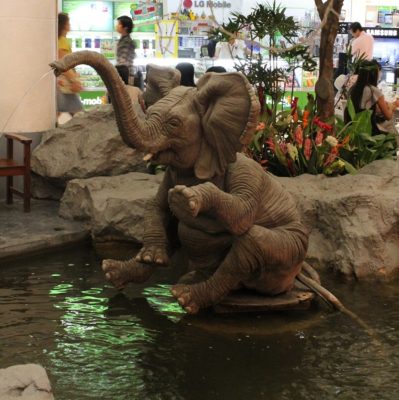
I remember 25 odd years ago, when western shopping centers and malls began arriving on mass in Thailand; soon there was a barrage of criticism in the local media about the erosion of Thai culture and the effect these western shopping malls would have on future generations. One paper bemoaned that, for Bangkok children of this new generation and beyond, the first time they would see an elephant, a waterfall or a piece of the jungle would be the fake reconstructions inside their nearest, air-conditioned, background-music-supplied shopping Mall.
Watching the suburban masses drawn to shopping malls, like zombies in a scene from a ‘Night of the Living Dead’ movie, it is easy to criticize. Surely, there are literally dozens upon dozens of better options and ways to spend our personal time, ways that help improve who we are or, the way in which we live and the lives of those around us?
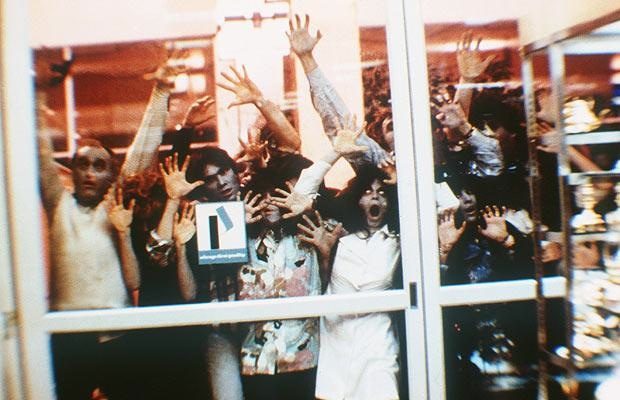
Malls for their part understood that merely offering a chance to shop was not the way of the future, Modern malls are easy, convenient places for families to just hang out on the weekend, they have parking, multiple activities, space to wander around, interesting things to see and do and plenty of places to eat and drink. In modern, rapidly growing Asian cities -where private investment substantially outpaces the ability of governments to keep up with the significant infrastructure required- the environments in these cities can be difficult to navigate, be polluted, congested and stressful; green spaces barely exist and getting about can often be arduous and even slightly dangerous. And so, people turn to the corner café or the local mall to hang out, environments that are usually close, clean, temperature controlled and safe. This also becomes possible with the evolution of a middle class and a modicum of disposal income, something that did not really exist here to any large degree, in decades gone by.
As suburbs grew, the drives into town became longer, congestion became an issue, parking was difficult in the cities and new suburbs were often a long way out and bereft of facilities and activities. Shopping areas became points of convergence, places where we would not go to merely do one thing or make a single purchase but, places where lots of people would go to do multiple things in a single trip and spend a good deal of time doing it. Another matter was that in the high density living of our cities, people lived on top of each other and shared their lives, whereas out in these sprawling new suburbs we were cut of by distance and time from the city and from people. What was needed in these cultural deserts was an oasis, a ‘third place’ for people to spend their time, a place that wasn’t home or the office/school but, another place where one could hang out with friends or, do things with the family and interact with their community.
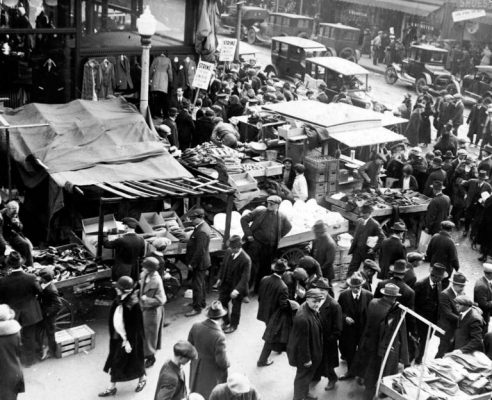
Malls had their birth sometime in 1920’s America, when the first supermarkets began to attract customers in large numbers and then small businesses grew around the supermarkets to form shopping streets or ‘strips’ as they became known. Somewhere around this time there came the establishment of off-street parking and then in 1931 Highland Park Shopping Village became the first group of stores that had its back to the access road and faced its own car park.
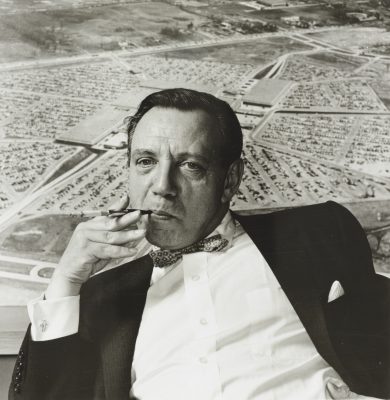
Gruen
In 1952, a gifted Austrian born architect by the name of Victor Gruen had been commissioned by the Daytona company to build the very first indoor, climate-controlled shopping mall, the ‘Southdale Center’ in Edina Minnesota, which opened in 1956.
Viktor David Grünbaum, as a young Austrian was a committed socialist and a respected architect with his own firm; he migrated from his home town of Vienna to the United States of America in 1938, when Nazi Germany annexed Austria. According to Malcolm Gladwell, in his article ‘The Terrazzo Jungle’ for The New Yorker, March 15, 2004: He arrived in New York at the age of 34, “with an architect’s degree, eight dollars, and no English.”
Victor changed his name to Gruen and started work as a draftsman, soon gaining acclaim for his design for the Lederer leather-goods boutique on Fifth Avenue. He received further commissions and recognition for his designs of shops that included Ciro’s on Fifth Avenue, Steckler’s on Broadway, Paris Decorators on the Bronx Concourse and eleven branches of the clothing chain Grayson’s.
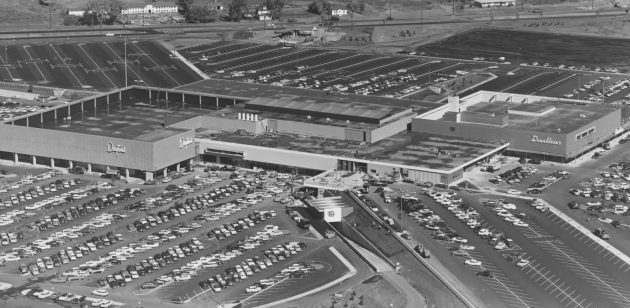
Gruen moved to Los Angeles in 1942 and a decade later founded his own architectural firm, Victor Gruen Associates. Gruen’s firm soon became one of the major town planners of the time; designing the first suburban open-air shopping facility called Northland Mall near Detroit in 1954 before opening his most famous work the 74,000 m2 Southdale Mall in Edina. Southdale was meant as the kernel of a full-fledged community and the mall was commercially successful, but the original design was never fully realized, the intended apartment buildings, schools, medical facilities, park and lake were never built.
In 1930’s America, when Gruen arrived in New York, getting people to go into shops was challenging, they didn’t have any money and so saw no reason to go in. Gruen realized this and began designing hyper-reality stores, with fascinating window displays and lavish interiors. Gruen argued that better design meant higher profits, noting that the more attractive the surroundings of a store, the longer customers would stay and shop and the more time they spent in the store, the more likely they were to make a purchase and spend more money on that purchase.
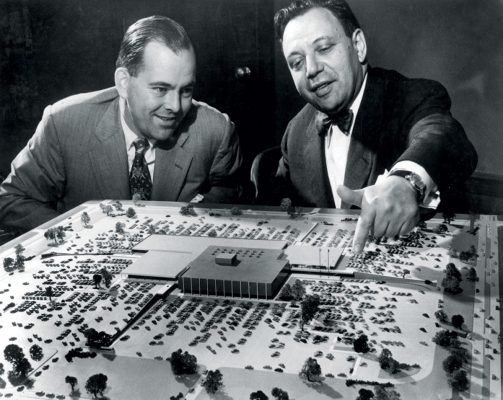
However, what Gruen imagined was a whole lot more than merely creating shopping malls, he did theoretical sketches of malls long before one was ever built and for a long time, none of his ideas came to fruition. What Gruen envisaged was a community center, a place of connection, a structure with offices, apartments, medical centers, child care facilities, learning centers, green spaces, a place to interact with people and feel connected, a place to forge a community, a cure all for the environmental, social and commercial problems out in these sprawling new suburbs, cut off from the urban world.

What developers ended up being interested in most, was the commercial aspects of Gruen’s imaginings. Up until the mid-1970s, Gruen’s office had designed over fifty shopping malls across the United States, yet Gruen himself returned to his native Vienna in 1968 and in a speech in London in 1978, Victor Gruen disavowed shopping mall developments as having “bastardized” his ideas.
What Gruen designed and created were spaces which felt comfortable and familiar in a hyper-reality kind of world, places where we would feel relaxed and happy to spend more time in, (which usually meant we would also be happy to spend more money in). Easy Listening and familiar music, waterfalls, sculptures, gardens, mood lighting.
What canny shop-owners created in their stores, were confused spaces and layouts within the malls, layouts where you would have to pass multiple purchase triggers and alternative buying opportunities before arriving at the one original item we wanted; which is why for example, the milk is always at the back of the store and the chocolate bars are right there staring pleadingly at you, (and well within reach of children) at the counter.

This created a psychological phenomenon known as the Gruen transfer, (or Gruen effect) named of course after Victor Gruen himself. The Gruen transfer is the moment when a person -who enters a shopping mall and is made to feel calm by an idealized hyper-reality -which is realized by deliberate reconstruction, to be familiar and safe- meets an intentionally confusing layout, loses track of their original intentions and so becomes much more susceptible to making impulse buys.
That is to say, a few minutes after you walk into a store, your brain becomes confused and is then hypnotized into making you buy more items than you originally intended.
The Gruen transfer was once a uniquely American phenomenon but, the last conventional shopping mall to be constructed in the U.S. was back in 2006, with online sales booming across the country. However, in Asia and many other pockets around the world, climate-controlled, mega malls remain thriving hubs for commercial, cultural and communal activity.
Gruen came to see himself more as town planner than architect and actually hated any tactic designed to manipulate consumers. He deeply regretted what the mall had quickly become, stating in 1978, “I refuse to pay alimony to those bastard developments, they have destroyed our cities.”
Victor Gruen died in 1980, but the commercial trend in the U.S. today, of creating “lifestyle centers” which are open, village like hubs, seem a lot closer to the sense of community that he had originally intended to create.

Epicurus
The famous Greek philosopher Epicurus reminds us that we replace emotional needs with commercial wants.
“Why then, if expensive things cannot bring us remarkable joy, are we so powerfully drawn to them? Because of an error similar to that of a migraine sufferer who drills a whole in the side of their skull: because expensive objects can feel like plausible solutions to needs that we don’t fully understand.
Objects mimic in a material dimension what we require in a psychological one. We need to rearrange our minds but are lured to new shelves. We buy a cashmere cardigan as a substitute for the counsel of friends.
We are not solely to blame for our confusions. Our weak understanding of our needs is aggravated by what Epicurus termed the ‘idle opinions’ of those around us, which do not reflect the natural hierarchy of our needs, emphasizing luxury and riches, seldom friendship, freedom and thought. The prevalence of idle opinion is no coincidence. It is in the interests of commercial enterprises to skew the hierarchy of our needs, to promote a material vision of the good and downplay an unsaleable one.
And the way we are enticed is through the sly association of superfluous objects with our own forgotten needs.
It may be a ‘Jeep’ we end up buying but it was –for Epicurus- freedom we were looking for.
It may be the aperitif we purchase but it was –for Epicurus- friendship we were after.
It may be the new bathing salts and oils we acquire but it was –for Epicurus- thought that would have brought us calm.”
Alain de Botton –The Consolations of Philosophy
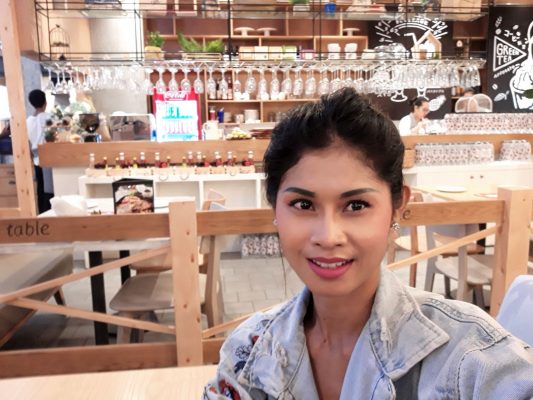
On The Table
On The Table is a Japanese style restaurant franchise by the highly successful Thai company, Zen Corporation, which has been in operation for almost 30 years and owns, operates and markets over a dozen restaurant brands. There are 17 On The Table outlets in Thailand, mostly centered in Bangkok.
The Phnom Penh franchise is owned and operated by the very successful family team behind the Ming Room, Master Suki Soup, Master Gold Group across Cambodia.
The décor at On The Table, AEON II is both comfortable and familiar, soft blond timber fixtures and furniture, wooden kitchen utensils and indoor plants with artistic sketches of kitchen bowls and other common items adorning the walls.
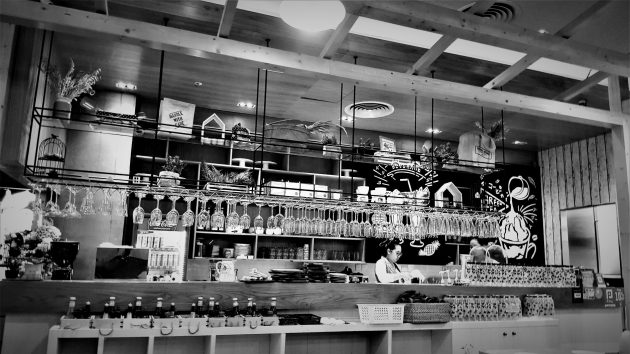
The Menu is extensive, a book, it’s a combination of Japanese dishes, western dishes and some well thought through fusions of both. Prices are mid-range and reasonable,the servings of noodle and rice dishes can be quite large.
We started with a salmon sashimi dish that was a sort of a mouthful or morsel of the spicy Thai salad ‘Som Tam’ and fresh, raw salmon. The medium intensity sourness and heat where there, along with good quality, fresh, rich in fatty amino acids salmon. A tasty and refreshing start.
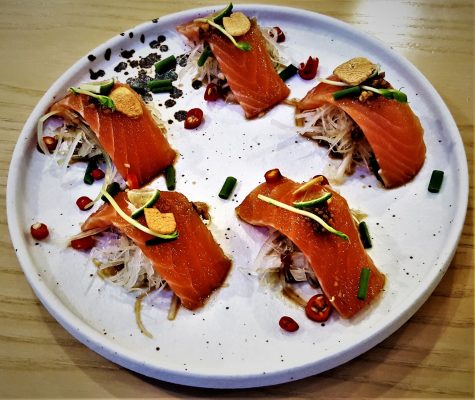
Next up was the bacon gyoza, exquisite Japanese pot-stickers with a perfectly cooked piece of bacon lounging tantalizingly across the top of the dumplings; like those models at Tokyo Car shows who drape themselves over sports cars as if they were lounge suites. If you subscribe to the common theory that bacon makes everything taste better and a little Maillard reaction only improves a dumpling, then this is all goodness.
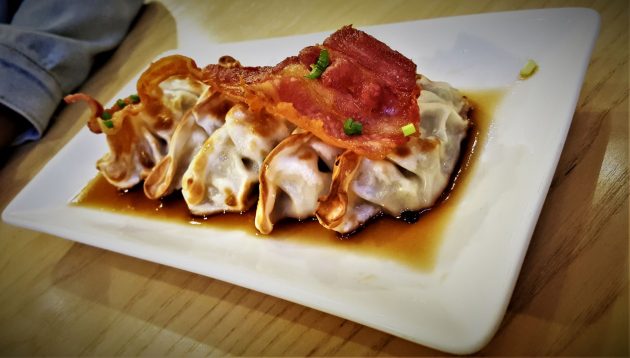
The next course was a California style sushi roll, wrapped in Parma ham and containing cream cheese, a fusion dish that created a beautiful creamy texture on the palate and lingering flavours of salty, fatty Parma, a very addictive combination.
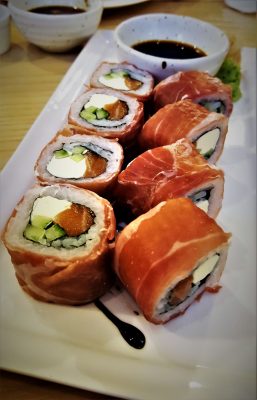
The main course was a katsu, a crumbed pork cutlet which was literally oozing with cheese into a rich, dark, Japanese vegetable curry over rice. The curry was very good, just as I like my Japanese curry, reasonable spice, thick texture and great intensity of flavour. The pork-and-cheese combination was wickedly rich in flavour and the whole dish just worked together very well.
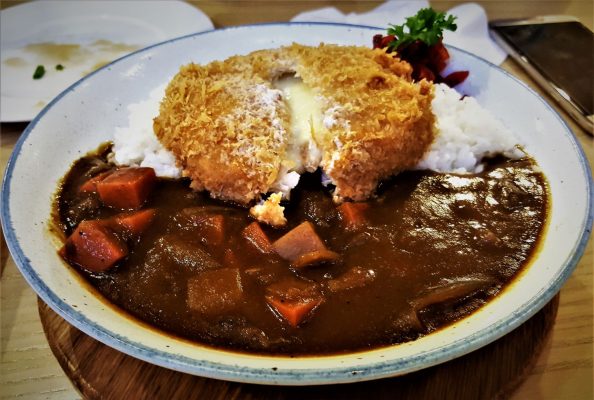
Completely stuffed full of delicious food, we were very content and headed off to catch our movie vowing to return, which we did the very next weekend with the whole family, (discovering the more than acceptable kid’s menu in the process).
Were my wife and I suffering from a bit of Gruen effect? Undoubtedly. Did I spend more than I intended to? Yes; there were a few other dishes my wife had and there were several drinks and all up the bill came in at just under $60 USD for the two of us. This was very reasonable to me but, I realize that to some it will seem quite a bit for two people to spend on dinner in a mall in Phnom Penh. However; there was an element of being excited upon reading the menu for the first time and wanting to sample quite a few different dishes with my mind on an article such as this.
It must be noted that we did finish all of the food, which really isn’t fair, seeing as I only have to read a good menu to put on weight, whilst my darling wife can regularly eat enough food to feed a small village and still has the body of a super model!
The new AEON in Sen Sok is to me, much more impressive and Gruen like than the first one over near Koh Pich; what is interesting is that the whole family loved the place and there are so many activities for the kids and places to eat that it is easy to see how it has quickly become a magnet for families on the weekends. There may be plenty more mind expanding, healthy, fitter outdoor or indoor activities to get up to but, the odd day out as a family, to the a modern new local mall, where the kids can safely run around and the air is clean can’t be an entirely bad thing, especially going by the smiles on their faces.
The good quality and well prepared dishes on offer at On The Table only makes it all the more bearable for a food tragic, avowed shopping hater like me.
